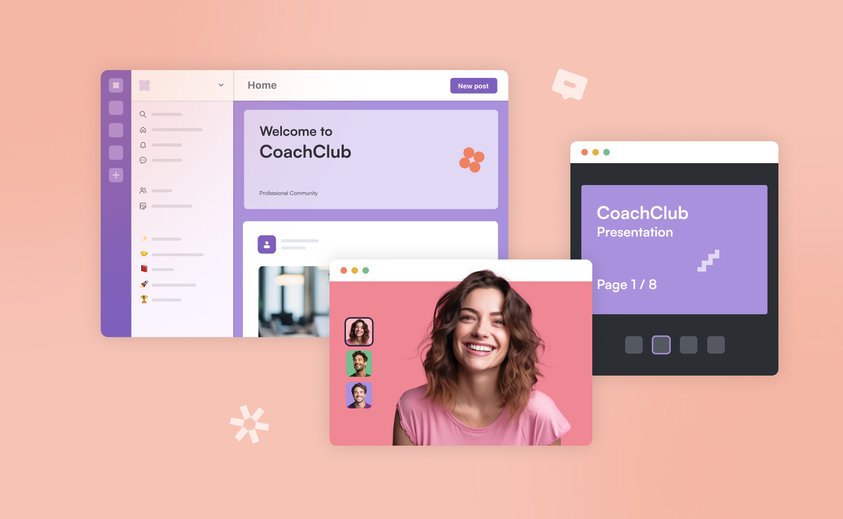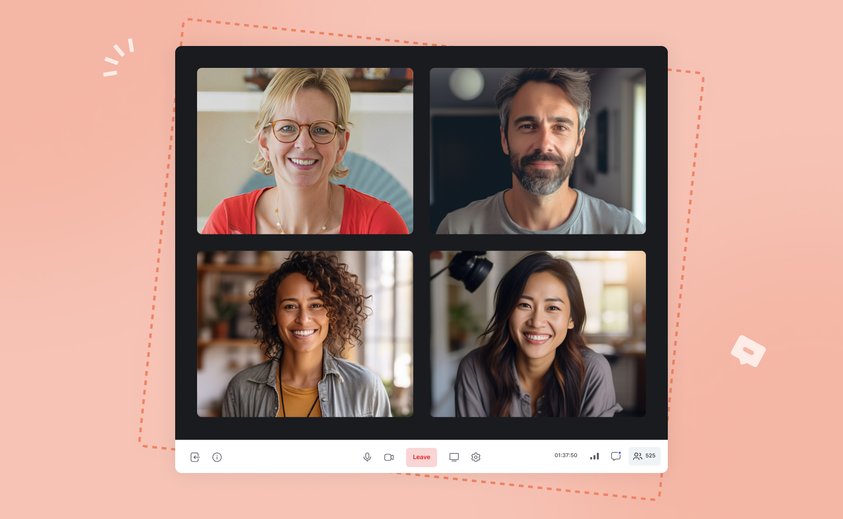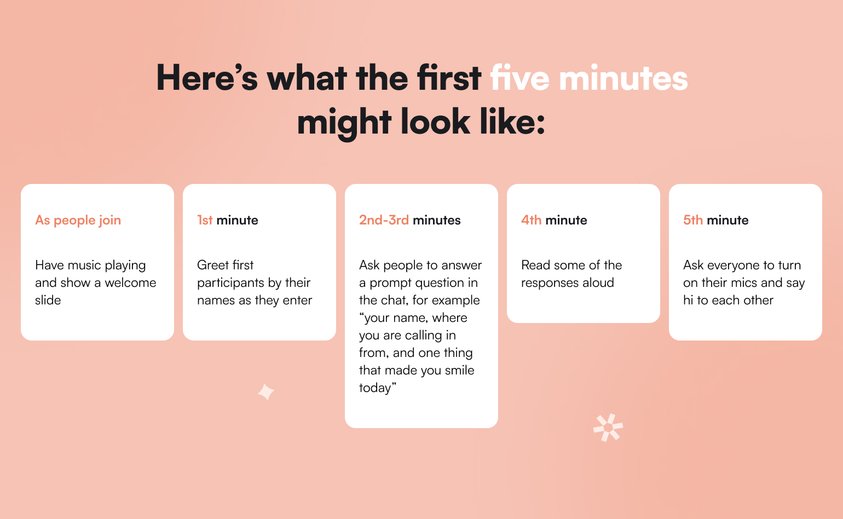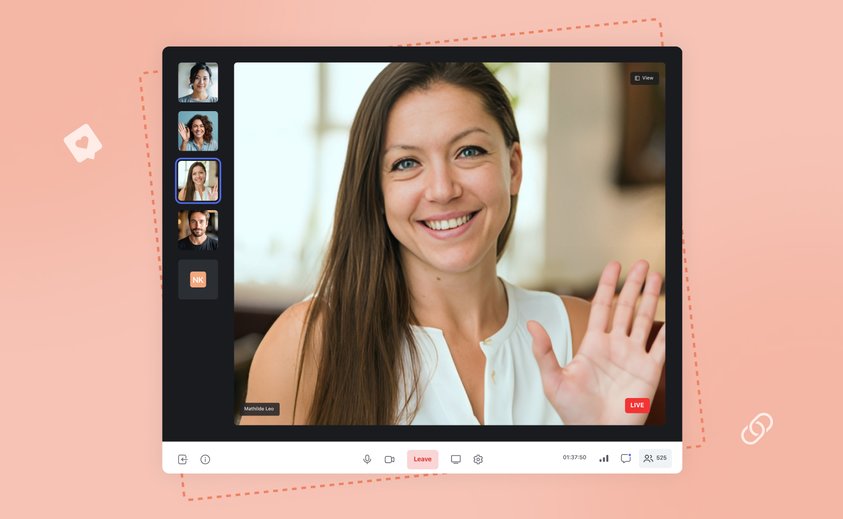7 Pro tips for hosting engaging community events (every single time)
Do you ever wonder what makes some live online community events full of excitement, engagement and energy while others feel downright exhausting?
It all boils down to one thing: you!
When you host live online events you are the one who creates the conditions for engagement.
As the host, it’s up to you to create the right conditions for participants to share their ideas, bond with other group members, and take action.
Because once you do… That’s when the group chat will be buzzing with insightful comments. That’s when you’ll see virtual hands flying up in the group discussion. And that’s when people will feel empowered to participate and become active community members.
The problem is that getting people to engage in your live session can feel like pushing a boulder up a hill.
How do you get people to come out to your events? How do you ensure your community event is going to be valuable and not “just another meeting?” How do you build connections with your participants from the moment they join your event? And how do you encourage everyone (even the introverts!) to join in?
All of those answers can be found right here!
In this blog I’m going to share seven pro tips for hosting engaging community events.
First, I’ll walk you through the five most common mistakes that hosts make (and how to avoid them.) Then, I’ll share the seven pro-tips with ideas that you can use to fuel engagement in your event.
The biggest mistakes online hosts make (and how to avoid them)
Before we dive into how to increase engagement, I want to share the five most common mistakes that people who lead online sessions make. Unfortunately, these mistakes can sabotage your best attempts to increase engagement.
1. Too much content

Most people believe that the more content they cram into their session, the more valuable it will be.
But bombarding your group members with too many slides, graphs, and frameworks can be overwhelming—especially online.
Instead, you want to find the right balance between delivering content and interaction. This will make it easier for your group members to engage and then to take action after the session is finished.
2. Not enough connection
As the host, you can be so focused on delivering high-quality content, that creating connection amongst our group members takes a backseat.
The problem is that you don’t have the spontaneous connection online that happens in-person.
That’s why you need to proactively design and facilitate opportunities for your group members to connect early and often. It will build safety, belonging, and motivation to engage with your session.
3. The wrong icebreaker
Most people believe that throwing out random icebreakers is a sure-fire way to ease people into the session and get them talking.
Unfortunately, using the wrong activity at the wrong time can backfire. Big time. It can make people feel confused and even unsafe to take part in your session.
Instead you need to curate your activities so they fit in with the bigger purpose of your session.
4. Too little interaction
A lot of people wonder why when they launch a question to their groups the only thing they hear is crickets.
Our attention spans are short. Even shorter online. If you don’t give your group members regular opportunities to interact throughout the session, they’ll disengage.
Fortunately, we have even more tools online than in-person to boost interaction. Once you understand how to use the digital tools at your disposal you will transform your online session from dullsville into an immersive, multi- sensory experience.
5. Insufficient prep
Some people start their session only to realize that mics aren’t working, the internet connections are glitchy and they’ve got the wrong links.
Running a live online event can feel like a juggling act. On steroids. Things can go south in a matter of seconds. The problem is that your audience can tell when you’re unprepared. It will make them feel like they’ve wasted time showing up for your session.
So many of our challenges when it comes to boosting engagement can be solved with razor-sharp preparation and planning. Create a detailed outline that includes timings, talking points, and links (the right ones). And check your sound and video before you go live. You’ll feel more confident and at ease leading your event.
The truth about these mistakes.
These mistakes are easy to make.
When I switched from leading in-person sessions to leading groups online three years ago these were some of the very same things I was struggling with. Back then, there was no playbook for how to run highly engaging sessions.
But after a lot of trial-and-error, experimentation, and learning from others, I realized quickly that there’s a clear, methodical way to design and lead consistently great live sessions.
It’s not rocket science. But there is an art and science to doing it well.
Now I’m going to share the seven pro-tips so you can see exactly how to boost engagement in every event you lead.
If you want to get more tips like these on leading live online events, subscribe to my free weekly newsletter, The Quest, here. You’ll get actionable advice delivered straight to your inbox every Monday
Now, let’s lift the curtain for hosting engaging live community events.
Seven pro-tips for hosting engaging live community events

1. Get clear on your purpose
So many events fail to engage people because the purpose isn’t clear.
To engage your community members, your event needs to have a clear, unique purpose. One that is right-sized for your specific group. Ideally, one that takes them from where they are now to where they want to be.
Challenge yourself to come up with a purpose that clearly states:
- What you want to do
- For whom
- And why
For example, instead of the purpose being “to build community,” a deeper purpose could be “to create a trusted community of athletic coaches who we can share our struggles openly with so we can do our best work.”
2. Make an irresistible invitation
One of the biggest challenges that people face is getting people to come out to live events in the first place. There are about a million other events vying for your group’s attention.
That’s why you want to make what I call an irresistible invitation to your audience members. One that will help build safety, curiosity, and excitement – before the session even goes live.
I include three key pieces of information to increase the chances of people showing up:
- Share the purpose. What do you want to do? For whom? And why? (See the first point).
- Clarify expectations. What kind of experience can people expect? Will it be interactive? Are they expected to have their cameras on? Let people know on the invite so they come prepared.
- Sell the benefits. What would motivate your community members to come out to a live session—really? Find out. And then put it on the invitation.
3. Focus on the first five minutes
Our attention spans can be short. Even shorter than a goldfish’s. That’s about eight seconds.
The first five minutes of your event are mission-critical for engaging your audience. From the very first moment your group members join your event they are assessing whether it’s worth taking part. Or whether they should bounce over to Facebook to check dinner plans instead.
As the host, it’s your job to help people to ease into your online session space and get people engaging with your event straight away. You can do that by intentionally designing an opening welcome sequence to help create safety for people to ask questions, contribute their ideas, and open up.

4. Connect early and often
Community is a social experience. We are wired for connection. Community events can be a powerful way to accelerate and deepen group bonds.
But in order for this to happen, you can’t throw a bunch of strangers in a room and expect them to bond immediately. You need to intentionally nurture the connection between members so they’re more likely to engage with each other.
Here are three ideas to build connection early and often:
- Ask a prompt question at the beginning of the event that goes beyond name and place to help the group get to know each other. For example “one hat you wear outside of work.”
- Run a breakout group within the first ten minutes of the event and have people share “what made them say yes” to joining the event.
- Vary group sizes to include individual reflection time, sharing in pairs, small groups, and big groups.
5. Less content, more interaction
There is nothing that shuts down engagement more quickly than too much content. Too many slides can overwhelm your audience members. Too much of one person talking is exhausting.
You want all of your participants to pay attention, engage, and get their voices heard. This is where you can use a full range of interactive tools to help you get everyone chiming in. Give options that work for introverts and extroverts.
Here are three of my go-to tools:
- Polls: They give your group members an easy way to engage they help you survey the group quickly.
- Word clouds: This gives your group a visual way to highlight common words and ideas related to your event.
- Whiteboards: These give your group a space where they can collaborate, co-create, and share ideas.
6. Give time for reflection
Reflection helps your group members make meaning of insights and takeaways from your live event. The problem is that so many hosts skip the reflection completely.
But this is one of the juiciest parts of a group experience!
Including time for reflection can spark new insights and breakthroughs. And it can help your group members find ways to take action on what they have experienced.
Here are three ways you can lead a powerful group reflection:
- Ask open-ended questions. These are questions that usually start with “what” and “how” that help spark discussion. For example, “What struck you…?”, “What did you learn…?”, “How might you apply what you’ve learned to your community events?”
- Actively listen. Pay attention to what’s being said. Resist jumping in with your opinions. Reflect back what you’ve heard. Be OK with silence. Sometimes people need a few moments to collect their thoughts.
- Stay purpose-focused. It’s very easy for the group discussion to veer off track. As the host it’s your job to stay on purpose. Refer back to the aim of your session if the conversation goes on a tangent. And don’t be afraid to respectfully interrupt overtalkers if you need to.
7. Close with intention

Like every great story, engaging events have a beginning, a middle, and an end. The end is often the most memorable part of a community experience.
The problem is that most hosts skip the ending altogether. This leaves your participants feeling frazzled.
The closing gets all voices heard one last time. It gives your group members closure. And it will end your session on an emotional high.
Here are three ideas:
- Give group members a final prompt in the chat to share insights.
- Share a closing quote connected to the theme of your event.
- Turn on your mics and wave goodbye.
Hosting engaging community events is a skill that you can hone with practice. Follow these seven pro tips and you’ll see engagement skyrocket. You’ll feel energized. And your community members will rave about your events.
About the author, Gwyn Wansbrough
Hi, I’m Gwyn. I’m on a mission to help you design and lead engaging live online sessions that get better results for your groups. I’m a facilitator and experience designer who has spent 1,000s of hours leading live events on Zoom—literally! I’ve trained nearly 1,500 professionals to lead dynamic, engaging virtual sessions that put the joy back into working and learning online. I run a five-week live online cohort-based course called Breakthrough Facilitation. I write a weekly newsletter called The Quest with actionable insights and tips for leading live online sessions. And I offer one-to-one coaching and custom training programs. Visit www.gwynwansbrough.com to learn more.
Want more tips like these? Subscribe to The Quest to receive curated resources and tips like these delivered straight to your inbox every Monday 👉 here.
Looking to improve how you run events for your community members?
Circle’s community platform brings together your members, discussions, events, courses, and content—all in one place, under your own brand. Plus, you get access to our customer community full of handy resources and over 8,000 community builders on the same journey as you.